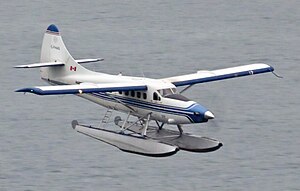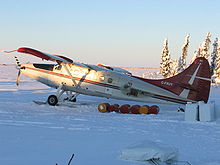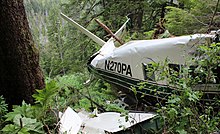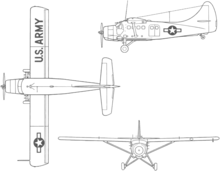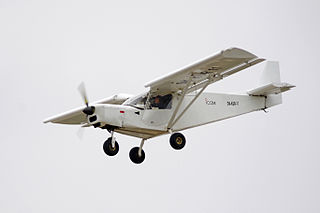
A short takeoff and landing (STOL) aircraft is a conventional fixed-wing aircraft that has short runway requirements for takeoff and landing. Many STOL-designed aircraft also feature various arrangements for use on airstrips with harsh conditions. STOL aircraft, including those used in scheduled passenger airline operations, have also been operated from STOLport airfields which feature short runways.
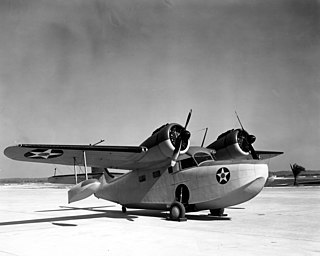
The Grumman G-21 Goose is an amphibious flying boat designed by Grumman to serve as an eight-seat "commuter" aircraft for businessmen in the Long Island area. The Goose was Grumman's first monoplane to fly, its first twin-engined aircraft, and its first aircraft to enter commercial airline service. During World War II, the Goose became an effective transport for the US military, as well as serving with many other air forces. During hostilities, the Goose took on an increasing number of combat and training roles.
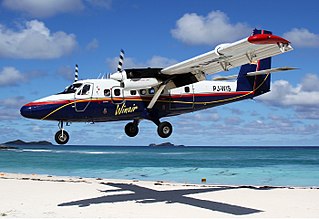
The de Havilland Canada DHC-6 Twin Otter is a Canadian STOL utility aircraft developed by de Havilland Canada in the mid-1960s and still in production today. De Havilland Canada produced it from 1965 to 1988; Viking Air purchased the type certificate, then restarted production in 2008 before re-adopting the DHC name in 2022. In 2023 DHC restarted production of the 300 series, in addition to the Series 400 produced by Viking. The aircraft's fixed tricycle undercarriage, STOL capabilities, twin turboprop engines and high rate of climb have made it a successful commuter airliner, typically seating 18–20 passengers, as well as a cargo and medical evacuation aircraft. In addition, the Twin Otter has been popular with commercial skydiving operations, and is used by the United States Army Parachute Team and the 98th Flying Training Squadron of the United States Air Force.

The de Havilland Canada DHC-2 Beaver is a single-engined high-wing propeller-driven short takeoff and landing (STOL) aircraft developed and manufactured by de Havilland Canada. It has been primarily operated as a bush plane and has been used for a wide variety of utility roles, such as cargo and passenger hauling, aerial application, and civil aviation duties.

Harbour Air Seaplanes is a scheduled floatplane service, tour and charter airline based in Richmond, British Columbia, Canada. The predominantly seaplane airline specializes in routes between Vancouver, Nanaimo, Victoria, Sechelt, Comox, Whistler and the Gulf Islands, primarily with de Havilland Canada floatplanes. Harbour Air operates de Havilland Beavers, Otters and Twin Otters.
De Havilland Aircraft of Canada Limited (DHC) is a Canadian aircraft manufacturer that has produced numerous aircraft models since its inception including the popular Dash 8. The company's primary facilities were located in the Downsview area of Toronto, Ontario for many years; in 2022, it was announced that it would relocate primary manufacturing to De Havilland Field, under development near Calgary, Alberta. The aircraft types currently in production or planned for production include the DHC-6 Twin Otter, DHC-8 Dash 8, and DHC-515 Firefighter.

West Coast Air was a Canadian scheduled airline operating de Havilland Canada DHC-6 Twin Otter float planes, which was integrated into Harbour Air Seaplanes.

The de Havilland Canada DHC-7, popularly known as the Dash 7, is a turboprop-powered regional airliner with short take-off and landing (STOL) performance. Variants were built with 50–54 seats. It first flew in 1975 and remained in production until 1988 when the parent company, de Havilland Canada, was purchased by Boeing in 1986 and later sold to Bombardier. In 2006 Bombardier sold the type certificate for the aircraft design to Victoria-based manufacturer Viking Air.

Austin Airways was a passenger airline and freight carrier based in Timmins, Ontario, and one of the oldest in Canada.

Kenmore Air Harbor, Inc., doing business as Kenmore Air, is an American airline with its headquarters on the grounds of Kenmore Air Harbor in Kenmore, Washington, United States, north of Seattle. It operates scheduled and charter seaplane and landplane service to destinations throughout western Washington and southwestern British Columbia, as well as seaplane "flightseeing" flights around Seattle. In addition to its corporate headquarters, seaplane maintenance facility and terminal in Kenmore, the airline has hub operations for seaplanes at its terminal on Seattle's Lake Union and for land planes at Seattle's Boeing Field/King County International Airport. It also operates a maintenance facility for its landplane fleet at Boeing Field.

The de Havilland Canada DHC-5 Buffalo is a short takeoff and landing (STOL) utility transport turboprop aircraft developed from the earlier piston-powered DHC-4 Caribou. The aircraft has extraordinary STOL performance and is able to take off in distances much shorter than even most light aircraft can manage.

The Fairchild F-11 Husky was a Canadian bush plane designed and manufactured in the post-Second World War era. Despite a promising design, a lack of a suitable powerplant hurt performance, and stiff competition from the de Havilland Beaver and de Havilland Otter designs meant the type never gained a solid foothold in the marketplace.
Metlakatla Seaplane Base is a state owned, public use seaplane base located in Metlakatla, a community on Annette Island in the Prince of Wales-Hyder Census Area of the U.S. state of Alaska.
Taquan Air is the operating name for Venture Travel, LLC, an American regional airline headquartered in Ketchikan, a city in the southeastern portion of the U.S. state of Alaska. It operates domestic scheduled passenger and charter services. Its base is Ketchikan Harbor Seaplane Base, which shares the same harbor and airspace as Ketchikan International Airport. As per the United States Department of Transportation in a report dated August 2, 2010, Taquan Air is a "U.S. Certificated Air Carrier", and is 1 of 125 such carriers in the US.

Soldotna Airport is a city-owned, public use airport located one nautical mile (1.85 km) southeast of the central business district of Soldotna, Alaska.

On 7 July 2013, a single-engine de Havilland Canada DHC-3 Otter, operated by air charter company Rediske Air, crashed on take-off at Soldotna Airport, Alaska. The sole crewmember and all nine passengers on board were killed. The crash was attributed to improper loading.

On 4 August 2018, a de Havilland Canada DHC-2 Beaver aircraft operated by K2 Aviation crashed in poor weather near Denali, Alaska, United States. All five people on board survived the crash, but died before rescuers were able to arrive at the scene. The five people consisted of the pilot and four Polish tourists.

Taquan Air Flight 20 was a regularly scheduled commuter flight operated by Taquan Air from Ketchikan Harbor Seaplane Base to Metlakatla Seaplane Base. On May 20, 2019, the pilot lost control of the de Havilland Canada DHC-2 Beaver floatplane while landing in the harbor at Metlakatla, Alaska, United States. The airplane overturned, destroying the aircraft and killing both persons aboard. The accident was attributed to challenging wind conditions that proved too difficult for the relatively inexperienced pilot to handle.

On May 13, 2019, a de Havilland Canada DHC-2 Beaver floatplane operated by Mountain Air Service collided with a Taquan Air de Havilland Canada DHC-3 Turbine Otter floatplane over George Inlet, Alaska, United States. The DHC-2 broke up in mid-air with the loss of all four passengers and the pilot. The DHC-3 pilot was able to maintain partial control, but the aircraft sustained substantial damage in the collision and the subsequent forced landing; the pilot suffered minor injuries, nine passengers suffered serious injuries, and one passenger was killed. Both aircraft were conducting sightseeing flights under visual flight rules, which state that the pilot of each aircraft is responsible for visually ensuring adequate separation from other air traffic, commonly known as "see and avoid".

On September 4, 2022, a DHC-3 Turbine Otter single-engine floatplane on a passenger flight from Friday Harbor to Renton, Washington, U.S., crashed into the waters of Mutiny Bay near Whidbey Island, killing all ten people on board. The plane was operated by West Isle Air doing business as Friday Harbor Seaplanes, a service owned by Northwest Seaplanes.
